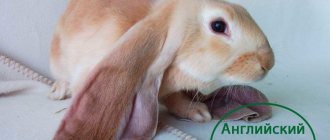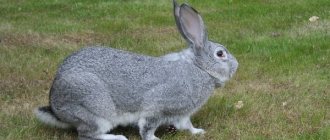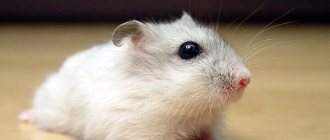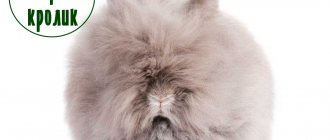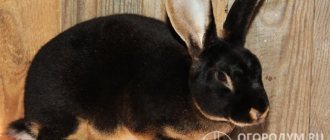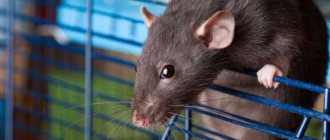Rex is Latin for "royal". And it is these animals that truly deserve to bear such a title. The Rex rabbit breed is quite famous among rabbit breeders, and is remembered for its unique plush fur coat. In addition to his stunning appearance, he has a peaceful and calm character. The animals are perfect for both home breeding and as show specimens.
Description of the breed
Photo:
Rex rabbits are a typical representative of the meat and skin direction in rabbit breeding. They are valued for their high-quality fur, as well as dietary meat with a pleasant taste.
External features and breed standard:
- rabbits grow up to 40-55 cm in length, have an elongated body and thin bones. The average weight of males is 4.5 kg, females are slightly less - 3 kg;
- at the age of 30 days, rabbits weigh up to 650 g. They slowly gain weight, by 130 days the body weight reaches only 2.4 kg;
- The muzzle of males is more powerful and wider than that of female rabbits. The head has a slightly rounded shape;
- in a healthy individual, the ears should stand strictly vertical, the average length is 11 cm;
- the tail is weakly expressed and lies close to the back;
- limbs of medium length;
- the eyes are brown, the claws should be the same shade or slightly darker;
- The fur is short-haired, up to 2 cm in length. Pleasant to the touch, the texture resembles high-quality velvet. After stroking in the opposite direction, the fur quickly falls into place;
- The mustache is a distinctive feature of the breed. They are very small in size and highly curved. Curvature appears even in newborn rabbits.
Rexes have a peaceful and calm character. They quickly get used to their owner, love to play and communicate. Adult healthy individuals should not demonstrate aggressiveness towards humans and other individuals.
Rabbits of this breed are very clean animals, they quickly get used to the tray and eat carefully. They do not tolerate rude treatment or loud noises. When frightened, they may experience aggression and bite. They note that rexes are sensitive to unpleasant odors; you should wash your hands before contacting the animal.
Temperament
Cute plush rabbits adapt well to the role of pets.
They have the right character:
- calm and flexible;
- friendly and sociable, willing to play with children and adults;
- love to walk in the fresh air;
- smart and well-trained, easily accustomed to the cat's litter box;
- female rabbits become affectionate and caring “mothers”;
- very shy and do not like unpleasant odors, they can bite someone who frightens them or smells unpleasant.
Origin story
Rexes are a young breed of rabbits. The appearance of characteristic species characteristics was the result of a random gene mutation. In 1919, a French farmer discovered his Belgian giant's litter with modified fur.
It was softer and shorter than that of the parent specimens. It was this trait that was subsequently fixed as a result of further selection, the breed was named after the Latin word meaning “king, king.”
In 1924, Rex rabbits were first exhibited at an exhibition in Paris, where they received rave reviews. After this, animals began to be exported to other countries, and the breed became in demand in the meat and skin industry.
In 1988, by crossing Dutch rabbits and rex rabbits, a dwarf variety called the Mini Rex rabbit was bred. They have a compact size and shorter hair length, making them suitable for keeping as a pet.
Feedback from livestock farmers
Irina, 32 years old, Tambov region
I have never kept such a breed (although there are rabbits on the farm), but my daughter chose a decorative Rex rabbit for herself based on the photo. The little animal turned out to be extremely cute (I’m not even talking about beauty). The rabbit is calm and surprisingly smart. Almost immediately he began to respond to the nickname, he got used to the tray without any problems. No aggression: affectionate, jumps funny, plays, loves to sit in your arms. True, he chews on everything (when not in a cage), but this is a feature of the species. And so, a pre-cute creature. I recommend it to everyone as a pet, especially to families with children.
Georgy, 44 years old, Mozhga
For many years I kept Rexes - black, light gray and “marders”. I didn't notice any problems. I immediately placed the rabbits in an insulated shed. He made sure that they were properly fed, vaccinated and not “damp.” And the income from the skins turned out to be quite good, as long as a friend lived nearby who knew how to process them. This is not an easy task: you have to be an excellent craftsman to bring out all the beauty of the fur and not spoil anything. Even a regular clientele has developed among familiar furriers. Now my friend has left, and there is no one to bring the skins into marketable condition. I think I’ll still choose the time and learn how to process it myself. They even ask me for fur, and I don’t want to lose income.
Varieties, color
The breed standard includes 20 colors, which is valuable for making clothing because the fur does not need to be dyed. The most common types of Rex are white, blue, black and chocolate fur.
The most famous varieties of the breed:
- Marder . The color of the fur imitates the color of a marten. Rabbits of traditional size, as well as dwarf representatives, were bred in this direction. They are considered the most decorative and expensive variety of the breed;
- Castor . The skin resembles natural beaver fur. Dwarf rexes of this species are especially popular;
- Chinchilla . The fur is as close as possible to the color of a chinchilla. When properly processed, it is practically indistinguishable from the skin of this animal; it is often used to create clothing;
- Mini . Grown only as an ornamental animal. The weight of an adult does not exceed 2 kg, and there is a wide variety of fur colors.
Since 2002, long-eared rexes, bred for home keeping, have become very popular. They are distinguished by very beautiful hair, small size and large hanging ears. This variety is not yet included in the breed standard.
Productive qualities
The weight of an adult rex can reach 5 kg. Due to the fact that it has light bones, most of the live weight is dietary and very tasty meat. Rex gains weight relatively quickly: 2 – 2.5 kg in 4 months. But other breeds of this type are more often bred for meat.
Find out how to fatten a rabbit for meat in a short time.
Royal rabbits are more prized for their original fur. In addition to high aesthetic qualities, it is very practical. The fur coat is denser than the furs of other breeds and is more wear-resistant. In addition, due to its special texture, the rex skin can be confused with the fur of more valuable fur-bearing animals. Therefore, it is highly valued among fur manufacturers.
Breeding
One of the main disadvantages of the Rex breed is low fertility. In one litter, the female brings up to 5 rabbits. They have a good maternal instinct, but with illiterate care there is a high risk of death of the offspring. To preserve the babies, it is recommended to place the baby rabbits with other breeds.
Puberty occurs at 3-4 months. Only young and healthy males should be selected for mating. It is recommended that mating be carried out in the male's cage to avoid aggression from the female rabbit.
The process is carried out exclusively during the period of sexual heat of females, which in the summer is repeated cyclically every other week and lasts up to 8 days. Usually a specific pair is selected for mating to preserve species characteristics; on large farms the coverage rate is 1 male for 6-8 females.
The mating process takes up to 30 seconds to achieve 100% fertilization; it is advisable to carry out coating twice with an interval of 5 minutes. Some rabbit breeders practice control mating after 5-6 days.
The duration of pregnancy is 28-31 days, giving birth usually occurs in the autumn. Animals have a bicornuate uterus, which complicates the birth process.
The presence of a person is mandatory to reduce the risk of death of the female. Average duration is 60 minutes. With high-quality feeding, the milk production of females is high; they can easily feed up to 6 babies.
Rex character
Western owners of Rex rabbits claim that these animals have one of the most developed intelligences among rabbits. Female rabbits have a well-developed maternal instinct and they even accept other people's rabbits. Due to their high intelligence, Rex cats can be kept together in one apartment. True, there is one pitfall here.
In addition to their ability to get along with members of their own breed, Rex rabbits also have a desire for physical movement. Rex easily takes on barriers a meter high. Rex's behavior is very similar to that of a cat.
Now imagine that there are two cats weighing almost 5 kg in the house who decided to play. Yes, just like with a cat: everything that the Rex can reach must be moved away. Breakable objects will be broken, chewable objects will be eaten. The situation will not change much, even if you get dwarf rexes. Almost 2 kg of muscles and bones rushing at high speed is also sensitive.
But Rexes have advantages that outweigh such minor inconveniences: they are easily litter box trained and amenable to training. They can be trained to come on command and stand on their hind legs. And in agility this is one of the best breeds.
Feeding
Rexes are unpretentious when it comes to feeding, but proper diet planning directly affects the health of the rabbits and the condition of their fur.
The following ingredients are used to compose your daily diet:
- in winter - grain, hay, compound feed, root vegetables and vegetables, twigs;
- in summer - grains and cereals, grass, tree branches, fresh vegetables.
Regardless of the season, it is recommended to add vitamin supplements for rabbits. Feeding rates are calculated taking into account age, gender and the presence of lactation.
Approximate volume:
- female and male during the resting period - 160 g;
- during the period of preparation for mating - 220 g;
- female during lactation - 300-550 g;
- young animals from 40 to 60 days – 125 g;
- young animals from 61 to 90 days – 175 g.
It is advisable to feed three times a day - at 8, 14 and 19 hours. There should always be access to fresh and clean water in the cage; the number of feeders and drinkers depends on the size of the herd.
It is not recommended to feed rabbits red beets, cauliflower, tomatoes and beans. The consumption of pine twigs and potato tops should be limited. It is strictly forbidden to give herbs growing in swampy areas, as well as ornamental plants.
Diet
This breed has an intense metabolism. The animal's diet must include hay and complete pellets. To grind down teeth, you can give branches of deciduous trees.
Stone fruit trees contain a large percentage of hydrocyanic acid, which is necessary for good digestion. Water should always be clean and fresh.
Animals are prohibited from giving:
- Beans;
- Cauliflower;
- A large amount of white cabbage;
- A large number of tomatoes;
- Large amount of salad.
Content
Rex rabbits are unpretentious animals. They feel comfortable even at low temperatures; thanks to their thick wool, they are able to withstand frosts down to -25-30 °C, but do not tolerate heat well.
Optimal temperature conditions for rabbits are 15-25 oC. Rex can be kept in an enclosure, cage or apartment. They can be kept one individual at a time, but it is best to arrange paired rooms, placing animals according to gender. In large rex farms, 4-6 individuals are kept in each cage.
The room for the animal should be spacious so that the rabbits can move around calmly and stand on their hind legs. Be sure to have a place to sleep and shelter.
In summer, rabbits can be kept in an enclosure with a large walking area; in winter, it is recommended to move animals to a heated room protected from precipitation and wind. There should be lighting inside, feeders and drinking bowls should be installed.
Advantages and disadvantages
- The advantages include the following features of the breed:
- tasty lean meat;
- beautiful valuable fur;
- flexible character;
- good metabolism affects the rapid growth and puberty of rabbits;
- excellent cold resistance: easily tolerates temperatures of 20°C and below;
- unpretentiousness in food.
- Among the disadvantages it should be noted:
- does not tolerate heat above +20°C;
- reproduces slowly;
- requires careful care and special conditions;
- susceptible to various diseases;
- timidity;
- does not tolerate unpleasant odors.
Rules of care
Caring for the Rex breed is simple. To ensure the health and development of animals, it is necessary to clean the premises weekly, clean the feeders, and it is advisable to change the water every day.
Animals must be combed to maintain the condition of their fur and to avoid the appearance of tangles. If necessary, their nails are trimmed.
In addition, it is important to carry out all veterinary measures - regular examinations of animals, routine vaccinations and preparation for mating.
A little about genetics
Spontaneous mutations of this gene, which is responsible for the development of fur, occur not so rarely, resulting in animals with original-looking hair. The gene is recessive and has little chance of appearing in nature. But man preserves and breeds such animals. Rex cats with wavy hair, three breeds of guinea pigs, a breed of geese with curly feathers.
One of the dog breeds that carries the mutated gene is very common in the world. This is a poodle.
But since the gene is recessive, it can be easily hidden by crossing a carrier animal with a representative of another breed that does not have this mutation.
It was this circumstance that the geneticist A.S. took advantage of. Serebrovsky, while on a scientific trip to Germany.
In the mid-1920s, the export of Rex rabbits from Germany was banned. But Serebrovsky crossed the Rex with another breed. The gene is recessive. According to Mendel's law, it will not appear in the first generation. The dominant gene will cover it. This means that the offspring of a rabbit of state value and a rabbit of another breed did not look at all like a rex.
Since animals that did not belong to a breed prohibited for export were presented at the border, Serebrovsky was allowed through.
Then it's a matter of technique. Individuals of the exported litter interbreed with each other. In the second generation, according to the same Mendelian law, 25% of the rabbits turn out to be rexes and another 50% are carriers of the desired gene. This is how the young Soviet Union acquired Rex rabbits, according to legend.
The only thing that's confusing is the dates. The breed was introduced to the world in the mid-20s in France, it immediately came from somewhere in Germany and even with an export ban, and at the same time a Soviet scientist was smuggling rabbits of this breed.
Diseases and their treatment
Rexes are prone to all the typical rabbit diseases. Pododermatitis or corns occur. To avoid this dangerous disease, it is important to properly arrange the floor in the rabbitry and avoid mesh covering.
Animals often suffer from rhinitis of an infectious and cold nature.
To prevent infection, the microclimate in the room should be controlled, vaccinations should be carried out in a timely manner and vitamins should be given to improve health. And if you do not regularly comb the hair, it loses its decorative appearance, and there is a risk of developing alopecia.
As a mandatory vaccination, young animals are vaccinated against myxomatosis, viral hemorrhagic fever and rabies.
Price
The cost of Rex rabbits depends on the level of the breeder, the external characteristics of the animals and the pedigree. Animals of traditional size with white, black or blue coat color can be purchased for 1500-6000 rubles.
Breeding individuals, as well as healthy and young males, are especially highly valued. The price for decorative mini-rexes starts from 700 rubles, directly depends on color and age.
When choosing Rex, it is important to pay attention to the condition of the skin. There should be no bald patches or signs of hair loss. The fur does not lie on the body, it is evenly distributed over the entire surface.
The length of the guard hair should be approximately equal to the undercoat. Curly hair is considered a fault of the breed standard; small amounts are allowed only in the area behind the ears.
How to choose a Rex rabbit
Buying a baby rex rabbit is not very easy. This is due to two reasons:
- This is a rare breed due to its infertility.
- Fakes are often found (more precisely, small rexes are easily confused with other rabbits or, for example, with a chinchilla).
Read more about how to raise rabbits as a business.
Useful tips
To be sure that the purchased rabbit is a purebred and healthy Rex, it is best to contact experienced breeders with a good reputation. You should not take individuals younger than 2 months. First you need to make sure that the chosen baby is healthy:
- uniform coat without bald patches;
- strong bones;
- moderate fatness;
- the fur is dense and shiny;
- dry nose;
- the tail is clean, without discharge;
- eyes are clear and lively;
- the rabbit is active, not lethargic;
- if you take him by the scruff of the neck, he is tense, like a spring, and does not hang passively.
Signs of purebredness
The main characteristics of a purebred Rex are known:
- wool hairs grow vertically;
- if you stroke a small rex, its fur does not smooth out, but returns to its original position;
- the coat is not wavy, curls can only be on the back of the head and belly;
- ears stick out vertically, without drooping;
- the shape of the body and head must correspond to the breed;
- the mustache is short and curled;
- small rexes and chinchillas are very similar and resemble plush toys. They are easy to confuse.
Check out such meat-and-skin rabbit breeds as: Soviet chinchilla, Butterfly, Gray giant, White giant and Chinchilla rabbit.
How to distinguish chinchilla babies:
- the typical color for the breed is gray-blue, but in rabbits it may not match;
- light circles around the eyes;
- white spots on the belly;
- black spots on the tips of the ears.
